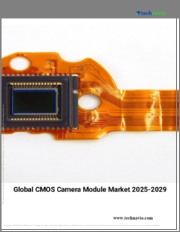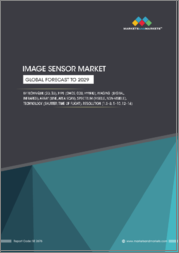
|
시장보고서
상품코드
1679166
CMOS 이미지 센서 시장 : 세계 산업 분석, 시장 규모·점유율·성장·동향, 예측(2025-2032년)CMOS Image Sensor Market: Global Industry Analysis, Size, Share, Growth, Trends, and Forecast, 2025 - 2032 |
||||||
Persistence Market Research는 최근 세계 CMOS 이미지 센서 시장에 대한 종합적인 보고서를 발표했습니다. 이 보고서는 시장 동인, 동향, 기회, 촉진요인, 과제 등 중요한 시장 역학을 철저히 평가하고 시장 구조에 대한 심층적인 통찰력을 제공합니다. 이 보고서는 2025년부터 2032년까지 세계 CMOS 이미지 센서 시장 예측 성장 궤적을 개괄하는 독점 데이터와 통계를 제공합니다.
주요 인사이트
- CMOS 이미지 센서 시장 규모(2025년) : 312억 5,000만 달러
- 시장 규모 예측(2032년) : 536억 6,000만 달러
- 세계 시장 성장률(CAGR, 2025-2032년) : 8.1%
CMOS 이미지 센서 시장 : 분석 범위
CMOS 이미지 센서는 가전, 자동차, 의료, 보안, 산업용 이미징 등 다양한 분야에서 중요한 역할을 하고 있습니다. 이러한 센서는 스마트폰, 디지털 카메라, 자율주행차, 의료용 영상 장비, 감시 시스템에 필수적인 구성 요소입니다. 고해상도 이미지에 대한 수요 증가, 센서 기술의 발전, 자동차 안전 및 산업 자동화 분야에서 CMOS 센서의 채택이 증가하면서 시장 성장을 주도하고 있으며, CMOS 이미지 센서는 저전력 소비, 높은 프레임 속도, 이미지 품질 향상 등의 장점을 가지고 있어 CCD 센서보다 선호되고 있습니다. 센서보다 선호되고 있습니다.
시장 성장 촉진요인:
세계 CMOS 이미지 센서 시장은 스마트폰, 태블릿, 가전제품의 고성능 카메라에 대한 수요 증가, 첨단운전자보조시스템(ADAS) 및 자율주행차와 같은 차량용 용도에서 CMOS 센서의 채택이 증가하고 있는 등 몇 가지 주요 요인에 의해 주도되고 있습니다. 시장 성장 촉진요인으로 작용하고 있습니다. 후면조사(BSI), 적층형 CMOS 센서, 월드 셔터 기술 등의 기술 발전으로 화질 향상, 소비전력 절감, 저조도 성능 향상 등이 가능해졌습니다. 또한, 내시경 검사나 안과 등 의료 진단에 CMOS 이미지 센서의 사용 확대가 시장 범위를 넓히고 있습니다. 또한, 보안용 스마트 감시 솔루션과 얼굴 인식 시스템의 인기가 높아지고 있는 것도 시장 확대에 기여하고 있습니다.
시장 성장 억제요인:
유망한 성장세를 보이고 있는 CMOS 이미지 센서 시장은 제조의 복잡성, 높은 개발 비용, 공급망 제약 등의 문제에 직면해 있습니다. 소형화 및 고화소화에 대한 요구는 제조 비용을 상승시키고, 제조 기술의 지속적인 혁신을 필요로 합니다. 또한, 비행시간(ToF) 센서 및 LiDAR와 같은 대체 이미징 기술과의 경쟁은 특정 용도에서 CMOS 이미지 센서의 채택을 어렵게 만들고 있습니다. 공급망 혼란, 반도체 공급 부족, 원자재 가격 변동은 시장 성장에 영향을 미치고 제조업체의 가격 압박으로 이어질 수 있습니다. 이러한 도전에 대응하기 위해서는 연구개발, 공급망 다각화, 기술 진보에 대한 전략적 투자가 필요합니다.
시장 기회:
CMOS 이미지 센서 시장은 기술 혁신, 새로운 응용 분야, 업계와의 제휴를 통해 큰 성장 기회를 창출하고 있으며, AI 기반 이미지 프로세싱과 엣지 컴퓨팅이 CMOS 센서에 통합되면서 자동차, 의료, 산업 자동화 분야의 기능을 강화할 것으로 예상됩니다. 이미징, 증강현실(AR), 가상현실(VR) 용도의 채택은 시장 수요를 더욱 촉진하고 있습니다. 또한, 사물인터넷(IoT)과 스마트 기기의 급속한 확장은 커넥티드 생태계에서 CMOS 센서의 통합을 위한 새로운 길을 열어줄 것입니다. 센서 제조업체, 반도체 기업 및 기술 기업 간의 전략적 파트너십은 새로운 기회를 창출하고 시장 성장을 유지하는 데 중요한 역할을 할 것으로 보입니다.
본 보고서에서 다룬 주요 질문
- CMOS 이미지 센서 시장의 세계 성장을 가속하는 주요 요인은?
- CMOS 이미지 센서의 보급에 기여하는 용도와 산업은?
- 기술 발전은 CMOS 이미지 센서 시장 경쟁 구도를 어떻게 형성하고 있는가?
- 시장 경쟁력을 유지하기 위해 어떤 전략을 채택하고 있는가?
- CMOS 이미지 센서 세계 시장에서의 새로운 트렌드와 전망은?
목차
제1장 주요 요약
제2장 시장 개요
- 시장 범위와 정의
- 시장 역학
- 성장 촉진요인
- 성장 억제요인
- 기회
- 과제
- 주요 동향
- 거시경제 요인
- 세계의 GDP 성장률
- 가전제품 수요 전망
- 경제 상황과 IT 예산 배분
- 연구개발에 대한 투자
- 반도체 제조에 대한 투자
- COVID-19의 영향 분석
- 예측 요인 : 관련성과 영향
제3장 부가가치 분석
- 규제 상황
- 밸류체인 분석
- PESTLE 분석
- Porter의 Five Forces 분석
제4장 가격 동향 분석
- 주요 하이라이트
- CMOS 이미지 센서 가격에 영향을 미치는 주요 요인
- 해상도별 가격 분석
제5장 세계의의 CMOS 이미지 센서 시장 전망 : 과거(2019-2024년)와 예측(2025-2032년)
- 세계의 CMOS 이미지 센서 시장 전망 : 해상도별
- 서론/주요 조사 결과
- 과거 시장 규모 분석 : 해상도별(금액 기준(10억 달러), 2019-2024년)
- 현재 시장 규모 분석과 예측 : 해상도별(금액 기준(10억 달러), 2025-2032년)
- VGA
- 1.3MP-3MP
- 5MP-10MP
- 12MP-16MP
- 16MP 이상
- 시장 매력 분석 : 해상도별
- 세계의 CMOS 이미지 센서 시장 전망 : 기술별
- 서론/주요 조사 결과
- 과거 시장 규모 분석 : 기술별(금액 기준(10억 달러), 2019-2024년)
- 현재 시장 규모 분석과 예측 : 기술별(금액 기준(10억 달러), 2025-2032년)
- 전면 조명
- 배면 조명
- 시장 매력 분석 : 기술별
- 세계의 CMOS 이미지 센서 시장 전망 : 용도별
- 서론/주요 조사 결과
- 과거 시장 규모 분석 : 용도별(금액 기준(10억 달러), 2019-2024년)
- 현재 시장 규모 분석과 예측 : 용도별(금액 기준(10억 달러), 2025-2032년)
- 가전제품
- 자동차
- 산업
- 항공우주 및 방위
- 의료
- 기타
- 시장 매력 분석 : 용도별
제6장 세계의 CMOS 이미지 센서 시장 전망 : 지역별
- 주요 하이라이트
- 과거 시장 규모 분석 : 지역별(금액(10억 달러) 기반, 2019-2024년)
- 현재 시장 규모 분석과 예측 : 지역별(금액(10억 달러) 기반, 2025-2032년)
- 북미
- 유럽
- 동아시아
- 남아시아 및 오세아니아
- 라틴아메리카
- 중동 및 아프리카
- 시장 매력 분석 : 지역별
제6장 세계의 CMOS 이미지 센서 시장 전망 : 지역
- 주요 하이라이트
- 과거 시장 규모(10억 달러)및 분석, 지역별, 2019-2024년
- 현재 시장 규모(10억 달러) 분석과 예측, 지역별, 2025-2032년
- 북미
- 유럽
- 동아시아
- 남아시아 및 오세아니아
- 라틴아메리카
- 중동 및 아프리카
- 시장의 매력 분석 : 지역
제7장 북미의 CMOS 이미지 센서 시장 전망 : 과거(2019-2024년)와 예측(2025-2032년)
제8장 유럽의 CMOS 이미지 센서 시장 전망 : 과거(2019-2024년)와 예측(2025-2032년)
제9장 동아시아의 CMOS 이미지 센서 시장 전망 : 과거(2019-2024년)와 예측(2025-2032년)
제10장 남아시아 및 오세아니아의 CMOS 이미지 센서 시장 전망 : 과거(2019-2024년)와 예측(2025-2032년)
제11장 라틴아메리카의 CMOS 이미지 센서 시장 전망 : 과거(2019-2024년)와 예측(2025-2032년)
제12장 중동 및 아프리카의 CMOS 이미지 센서 시장 전망 : 과거(2019-2024년)와 예측(2025-2032년)
제13장 경쟁 구도
- 시장 점유율 분석(2024년)
- 시장 구조
- 경쟁 강도 매핑 : 시장별
- 경쟁 대시보드
- 기업 개요(상세 : 개요, 재무, 전략, 최근 동향)
- Sony Semiconductor Solutions Corporation
- Samsung
- Omnivision Technologies Inc.
- ON Semiconductor
- STMicroelectronics
- SK Hynix Inc.
- GalaxyCore Inc.
- Himax Technologies Inc.
- SmartSens Technology
- Canon
- Toshiba
- Nikon
제14장 부록
- 분석 방법
- 분석 전제조건
- 두자어 및 약어
Persistence Market Research has recently released a comprehensive report on the worldwide CMOS Image Sensor Market. The report offers a thorough assessment of crucial market dynamics, including drivers, trends, opportunities, and challenges, providing detailed insights into the market structure. This research publication presents exclusive data and statistics outlining the anticipated growth trajectory of the global CMOS Image Sensor Market from 2025 to 2032.
Key Insights:
- CMOS Image Sensor Market Size (2025E): US$ 31.25 Bn
- Projected Market Value (2032F):US$ 53.66 Bn
- Global Market Growth Rate (CAGR 2025 to 2032): 8.1%
CMOS Image Sensor Market - Report Scope:
CMOS image sensors play a critical role in various applications, including consumer electronics, automotive, healthcare, security, and industrial imaging. These sensors are integral components in smartphones, digital cameras, autonomous vehicles, medical imaging devices, and surveillance systems. The market's growth is driven by increasing demand for high-resolution imaging, advancements in sensor technology, and the rising adoption of CMOS sensors in automotive safety and industrial automation. CMOS image sensors offer advantages such as low power consumption, high frame rates, and improved image quality, making them a preferred choice over CCD sensors.
Market Growth Drivers:
The global CMOS Image Sensor Market is propelled by several key factors, including the growing demand for high-performance cameras in smartphones, tablets, and consumer electronics. The increasing adoption of CMOS sensors in automotive applications, such as advanced driver-assistance systems (ADAS) and autonomous vehicles, further drives market growth. Technological advancements, including backside illumination (BSI), stacked CMOS sensors, and global shutter technology, enhance image quality, reduce power consumption, and enable superior low-light performance. Additionally, the expanding use of CMOS image sensors in medical diagnostics, such as endoscopy and ophthalmology, broadens the market scope. The rising popularity of smart surveillance solutions and facial recognition systems in security applications also contributes to the market's expansion.
Market Restraints:
Despite promising growth prospects, the CMOS Image Sensor Market faces challenges related to manufacturing complexities, high development costs, and supply chain constraints. The demand for miniaturization and higher pixel density increases production costs and requires continuous innovation in fabrication techniques. Additionally, competition from alternative imaging technologies, such as time-of-flight (ToF) sensors and LiDAR, poses a challenge to CMOS image sensor adoption in specific applications. Supply chain disruptions, semiconductor shortages, and fluctuating raw material prices may impact market growth and lead to pricing pressure on manufacturers. Addressing these challenges requires strategic investments in research and development, supply chain diversification, and technological advancements.
Market Opportunities:
The CMOS Image Sensor Market presents significant growth opportunities driven by technological innovations, emerging applications, and industry collaborations. The increasing integration of AI-powered image processing and edge computing in CMOS sensors enhances their functionality in automotive, healthcare, and industrial automation. The adoption of 3D imaging, augmented reality (AR), and virtual reality (VR) applications further fuels market demand. Additionally, the rapid expansion of the Internet of Things (IoT) and smart devices opens new avenues for CMOS sensor integration in connected ecosystems. Strategic partnerships between sensor manufacturers, semiconductor companies, and technology firms will play a crucial role in unlocking new opportunities and sustaining market growth.
Key Questions Answered in the Report:
- What are the primary factors driving the growth of the CMOS Image Sensor Market globally?
- Which applications and industries are contributing to the widespread adoption of CMOS image sensors?
- How are technological advancements shaping the competitive landscape of the CMOS Image Sensor Market?
- Who are the key players in the market, and what strategies are they employing to maintain a competitive edge?
- What are the emerging trends and future prospects in the global CMOS Image Sensor Market?
Competitive Intelligence and Business Strategy:
Leading players in the global CMOS Image Sensor Market, including Sony Corporation, Samsung Electronics Co., Ltd., OmniVision Technologies, and ON Semiconductor, focus on innovation, product differentiation, and strategic partnerships to gain a competitive edge. These companies invest heavily in R&D to develop high-resolution, energy-efficient, and AI-integrated CMOS sensors, catering to various industries such as automotive, healthcare, and consumer electronics. Collaborations with automotive manufacturers, medical device companies, and technology firms facilitate market expansion and drive adoption. Additionally, advancements in wafer fabrication, sensor miniaturization, and quantum dot technology enhance product performance and market competitiveness.
Key Companies Profiled:
- Sony Corporation
- Samsung Electronics Co., Ltd.
- OmniVision Technologies
- ON Semiconductor
- STMicroelectronics
- Canon Inc.
- Panasonic Corporation
- Teledyne Technologies Incorporated
- Hamamatsu Photonics K.K.
- Toshiba Corporation
CMOS Image Sensor Market Segmentation
By Resolution
- VGA
- 1.3 MP to 3 MP
- 5 MP to 10 MP
- 12 MP to 16 MP
- More than 16 MP
By Technology
- Front Side Illuminator
- Back Side Illuminator
By Application
- Consumer Electronics
- Automotive
- Industrial
- Aerospace and Defense
- Healthcare
By Region
- North America
- Europe
- East Asia
- South Asia and Oceania
- Middle East and Africa
- Latin America
Table of Contents
1. Executive Summary
- 1.1. Global CMOS Image Sensor Market Snapshot, 2025-2032
- 1.2. Market Opportunity Assessment, 2025-2032, US$ Bn
- 1.3. Key Market Trends
- 1.4. Future Market Projections
- 1.5. Premium Market Insights
- 1.6. Application Developments and Key Market Events
- 1.7. PMR Analysis and Recommendations
2. Market Overview
- 2.1. Market Scope and Definition
- 2.2. Market Dynamics
- 2.2.1. Drivers
- 2.2.2. Restraints
- 2.2.3. Opportunity
- 2.2.4. Challenges
- 2.2.5. Key Trends
- 2.3. Macro-Economic Factors
- 2.3.1. Global GDP Growth
- 2.3.2. Consumer Electronics Demand Outlook
- 2.3.3. Economic Conditions and IT Budget Allocation
- 2.3.4. Investment in R&D
- 2.3.5. Investment in Semiconductor Manufacturing
- 2.4. COVID-19 Impact Analysis
- 2.5. Forecast Factors - Relevance and Impact
3. Value Added Insights
- 3.1. Regulatory Landscape
- 3.2. Value Chain Analysis
- 3.3. PESTLE Analysis
- 3.4. Porter's Five Force Analysis
4. Price Trend Analysis
- 4.1. Key Highlights
- 4.2. Key Factors Impacting CMOS Image Sensor Prices
- 4.3. Pricing Analysis, by Resolution
5. Global CMOS Image Sensor Market Outlook: Historical (2019-2024) and Forecast (2025-2032)
- 5.1. Global CMOS Image Sensor Market Outlook: Resolution
- 5.1.1. Introduction / Key Findings
- 5.1.2. Historical Market Size (US$ Bn) and Analysis, By Resolution, 2019-2024
- 5.1.3. Current Market Size (US$ Bn) and Analysis and Forecast, By Resolution, 2025-2032
- 5.1.3.1. VGA
- 5.1.3.2. 1.3 MP to 3 MP
- 5.1.3.3. 5 MP to 10 MP
- 5.1.3.4. 12 MP to 16 MP
- 5.1.3.5. More than 16 MP
- 5.2. Market Attractiveness Analysis: Resolution
- 5.3. Global CMOS Image Sensor Market Outlook: Technology
- 5.3.1. Introduction / Key Findings
- 5.3.2. Historical Market Size (US$ Bn) Analysis, By Technology, 2019-2024
- 5.3.3. Current Market Size (US$ Bn) Analysis and Forecast, By Technology, 2025-2032
- 5.3.3.1. Front Side Illuminator
- 5.3.3.2. Back Side Illuminator
- 5.4. Market Attractiveness Analysis: Technology
- 5.5. Global CMOS Image Sensor Market Outlook: Application
- 5.5.1. Introduction / Key Findings
- 5.5.2. Historical Market Size (US$ Bn) Analysis, By Application, 2019-2024
- 5.5.3. Current Market Size (US$ Bn) Analysis and Forecast, By Application, 2025-2032
- 5.5.3.1. Consumer Electronics
- 5.5.3.2. Automotive
- 5.5.3.3. Industrial
- 5.5.3.4. Aerospace and Defense
- 5.5.3.5. Healthcare
- 5.5.3.6. Others
- 5.6. Market Attractiveness Analysis: Application
6. Global CMOS Image Sensor Market Outlook: Region
- 6.1. Key Highlights
- 6.2. Historical Market Size (US$ Bn) and Analysis, By Region, 2019-2024
- 6.3. Current Market Size (US$ Bn) Analysis and Forecast, By Region, 2025-2032
- 6.3.1. North America
- 6.3.2. Europe
- 6.3.3. East Asia
- 6.3.4. South Asia and Oceania
- 6.3.5. Latin America
- 6.3.6. Middle East & Africa
- 6.4. Market Attractiveness Analysis: Region
7. North America CMOS Image Sensor Market Outlook: Historical (2019-2024) and Forecast (2025-2032)
- 7.1. Key Highlights
- 7.2. Historical Market Size (US$ Bn) Analysis, By Market, 2019-2024
- 7.2.1. By Country
- 7.2.2. By Resolution
- 7.2.3. By Technology
- 7.2.4. By Application
- 7.3. Current Market Size (US$ Bn) Analysis and Forecast, By Country, 2025-2032
- 7.3.1. U.S.
- 7.3.2. Canada
- 7.4. Current Market Size (US$ Bn) Analysis and Forecast, By Resolution, 2025-2032
- 7.4.1. VGA
- 7.4.2. 1.3 MP to 3 MP
- 7.4.3. 5 MP to 10 MP
- 7.4.4. 12 MP to 16 MP
- 7.4.5. More than 16 MP
- 7.5. Current Market Size (US$ Bn) Analysis and Forecast, By Technology, 2025-2032
- 7.5.1. Front Side Illuminator
- 7.5.2. Back Side Illuminator
- 7.6. Current Market Size (US$ Bn) Analysis and Forecast, By Application, 2025-2032
- 7.6.1. Consumer Electronics
- 7.6.2. Automotive
- 7.6.3. Industrial
- 7.6.4. Aerospace and Defense
- 7.6.5. Healthcare
- 7.6.6. Others
- 7.7. Market Attractiveness Analysis
8. Europe CMOS Image Sensor Market Outlook: Historical (2019-2024) and Forecast (2025-2032)
- 8.1. Key Highlights
- 8.2. Historical Market Size (US$ Bn) Analysis, By Market, 2019-2024
- 8.2.1. By Country
- 8.2.2. By Resolution
- 8.2.3. By Technology
- 8.2.4. By Application
- 8.3. Current Market Size (US$ Bn) Analysis and Forecast, By Country, 2025-2032
- 8.3.1. Germany
- 8.3.2. France
- 8.3.3. U.K.
- 8.3.4. Italy
- 8.3.5. Spain
- 8.3.6. Russia
- 8.3.7. Turkey
- 8.3.8. Rest of Europe
- 8.4. Current Market Size (US$ Bn) Analysis and Forecast, By Resolution, 2025-2032
- 8.4.1. VGA
- 8.4.2. 1.3 MP to 3 MP
- 8.4.3. 5 MP to 10 MP
- 8.4.4. 12 MP to 16 MP
- 8.4.5. More than 16 MP
- 8.5. Current Market Size (US$ Bn) Analysis and Forecast, By Technology, 2025-2032
- 8.5.1. Front Side Illuminator
- 8.5.2. Back Side Illuminator
- 8.6. Current Market Size (US$ Bn) Analysis and Forecast, By Application, 2025-2032
- 8.6.1. Consumer Electronics
- 8.6.2. Automotive
- 8.6.3. Industrial
- 8.6.4. Aerospace and Defense
- 8.6.5. Healthcare
- 8.6.6. Others
- 8.7. Market Attractiveness Analysis
9. East Asia CMOS Image Sensor Market Outlook: Historical (2019-2024) and Forecast (2025-2032)
- 9.1. Key Highlights
- 9.2. Historical Market Size (US$ Bn) Analysis, By Market, 2019-2024
- 9.2.1. By Country
- 9.2.2. By Resolution
- 9.2.3. By Technology
- 9.2.4. By Application
- 9.3. Current Market Size (US$ Bn) Analysis and Forecast, By Country, 2025-2032
- 9.3.1. China
- 9.3.2. Japan
- 9.3.3. South Korea
- 9.4. Current Market Size (US$ Bn) Analysis and Forecast, By Resolution, 2025-2032
- 9.4.1. VGA
- 9.4.2. 1.3 MP to 3 MP
- 9.4.3. 5 MP to 10 MP
- 9.4.4. 12 MP to 16 MP
- 9.4.5. More than 16 MP
- 9.5. Current Market Size (US$ Bn) Analysis and Forecast, By Technology, 2025-2032
- 9.5.1. Front Side Illuminator
- 9.5.2. Back Side Illuminator
- 9.6. Current Market Size (US$ Bn) Analysis and Forecast, By Application, 2025-2032
- 9.6.1. Consumer Electronics
- 9.6.2. Automotive
- 9.6.3. Industrial
- 9.6.4. Aerospace and Defense
- 9.6.5. Healthcare
- 9.6.6. Others
- 9.7. Market Attractiveness Analysis
10. South Asia & Oceania CMOS Image Sensor Market Outlook: Historical (2019-2024) and Forecast (2025-2032)
- 10.1. Key Highlights
- 10.2. Historical Market Size (US$ Bn) Analysis, By Market, 2019-2024
- 10.2.1. By Country
- 10.2.2. By Resolution
- 10.2.3. By Technology
- 10.2.4. By Application
- 10.3. Current Market Size (US$ Bn) Analysis and Forecast, By Country, 2025-2032
- 10.3.1. India
- 10.3.2. Southeast Asia
- 10.3.3. ANZ
- 10.3.4. Rest of South Asia & Oceania
- 10.4. Current Market Size (US$ Bn) Analysis and Forecast, By Resolution, 2025-2032
- 10.4.1. VGA
- 10.4.2. 1.3 MP to 3 MP
- 10.4.3. 5 MP to 10 MP
- 10.4.4. 12 MP to 16 MP
- 10.4.5. More than 16 MP
- 10.5. Current Market Size (US$ Bn) Analysis and Forecast, By Technology, 2025-2032
- 10.5.1. Front Side Illuminator
- 10.5.2. Back Side Illuminator
- 10.6. Current Market Size (US$ Bn) Analysis and Forecast, By Application, 2025-2032
- 10.6.1. Consumer Electronics
- 10.6.2. Automotive
- 10.6.3. Industrial
- 10.6.4. Aerospace and Defense
- 10.6.5. Healthcare
- 10.6.6. Others
- 10.7. Market Attractiveness Analysis
11. Latin America CMOS Image Sensor Market Outlook: Historical (2019-2024) and Forecast (2025-2032)
- 11.1. Key Highlights
- 11.2. Historical Market Size (US$ Bn) Analysis, By Market, 2019-2024
- 11.2.1. By Country
- 11.2.2. By Resolution
- 11.2.3. By Technology
- 11.2.4. By Application
- 11.3. Current Market Size (US$ Bn) Analysis and Forecast, By Country, 2025-2032
- 11.3.1. Brazil
- 11.3.2. Mexico
- 11.3.3. Rest of Latin America
- 11.4. Current Market Size (US$ Bn) Analysis and Forecast, By Resolution, 2025-2032
- 11.4.1. VGA
- 11.4.2. 1.3 MP to 3 MP
- 11.4.3. 5 MP to 10 MP
- 11.4.4. 12 MP to 16 MP
- 11.4.5. More than 16 MP
- 11.5. Current Market Size (US$ Bn) Analysis and Forecast, By Technology, 2025-2032
- 11.5.1. Front Side Illuminator
- 11.5.2. Back Side Illuminator
- 11.6. Current Market Size (US$ Bn) Analysis and Forecast, By Application, 2025-2032
- 11.6.1. Consumer Electronics
- 11.6.2. Automotive
- 11.6.3. Industrial
- 11.6.4. Aerospace and Defense
- 11.6.5. Healthcare
- 11.6.6. Others
- 11.7. Market Attractiveness Analysis
12. Middle East & Africa CMOS Image Sensor Market Outlook: Historical (2019-2024) and Forecast (2025-2032)
- 12.1. Key Highlights
- 12.2. Historical Market Size (US$ Bn) Analysis, By Market, 2019-2024
- 12.2.1. By Country
- 12.2.2. By Resolution
- 12.2.3. By Technology
- 12.2.4. By Application
- 12.3. Current Market Size (US$ Bn) Analysis and Forecast, By Country, 2025-2032
- 12.3.1. GCC Countries
- 12.3.2. South Africa
- 12.3.3. Northern Africa
- 12.3.4. Rest of Middle East & Africa
- 12.4. Current Market Size (US$ Bn) Analysis and Forecast, By Resolution, 2025-2032
- 12.4.1. VGA
- 12.4.2. 1.3 MP to 3 MP
- 12.4.3. 5 MP to 10 MP
- 12.4.4. 12 MP to 16 MP
- 12.4.5. More than 16 MP
- 12.5. Current Market Size (US$ Bn) Analysis and Forecast, By Technology, 2025-2032
- 12.5.1. Front Side Illuminator
- 12.5.2. Back Side Illuminator
- 12.6. Current Market Size (US$ Bn) Analysis and Forecast, By Application, 2025-2032
- 12.6.1. Consumer Electronics
- 12.6.2. Automotive
- 12.6.3. Industrial
- 12.6.4. Aerospace and Defense
- 12.6.5. Healthcare
- 12.6.6. Others
- 12.7. Market Attractiveness Analysis
13. Competition Landscape
- 13.1. Market Share Analysis, 2024
- 13.2. Market Structure
- 13.2.1. Competition Intensity Mapping
- 13.2.2. Competition Dashboard
- 13.3. Company Profiles (Details - Overview, Financials, Strategy, Recent Developments)
- 13.3.1. Sony Semiconductor Solutions Corporation
- 13.3.1.1. Overview
- 13.3.1.2. Solution Portfolio
- 13.3.1.3. Key Financials
- 13.3.1.4. Market Developments
- 13.3.1.5. Market Strategy
- 13.3.2. Samsung
- 13.3.3. Omnivision Technologies Inc.
- 13.3.4. ON Semiconductor
- 13.3.5. STMicroelectronics
- 13.3.6. SK Hynix Inc.
- 13.3.7. GalaxyCore Inc.
- 13.3.8. Himax Technologies Inc.
- 13.3.9. SmartSens Technology
- 13.3.10. Canon
- 13.3.11. Toshiba
- 13.3.12. Nikon
- 13.3.1. Sony Semiconductor Solutions Corporation
14. Appendix
- 14.1. Research Methodology
- 14.2. Research Assumptions
- 14.3. Acronyms and Abbreviations



















